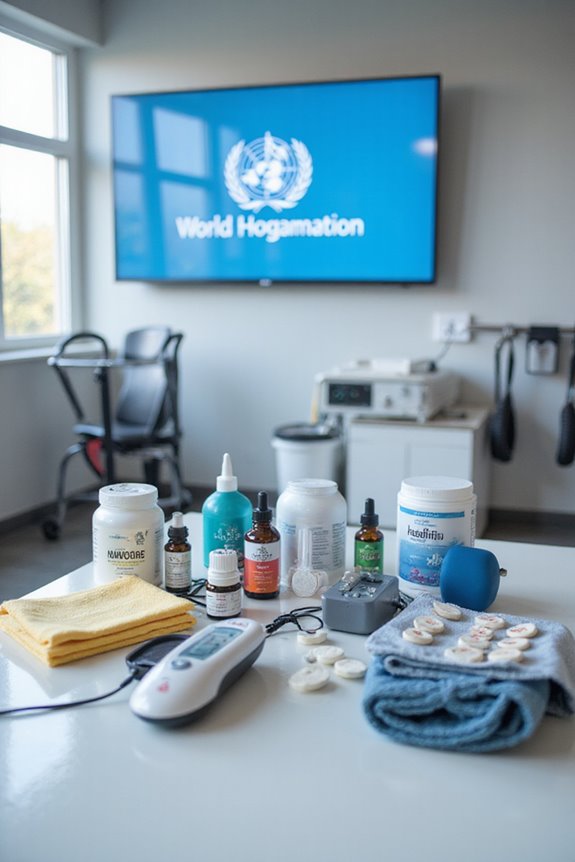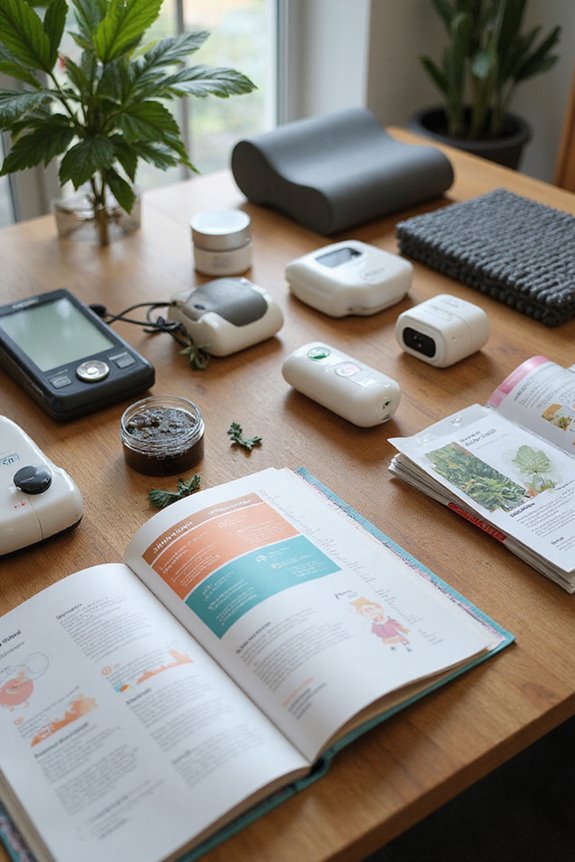Several international organizations focus on pain relief, including:
- International Association for the Study of Pain (IASP): Established in 1973, it unites over 7,200 professionals in 133 countries to enhance understanding and management of pain.
- Pain Relief International (PRI): This organization aims to provide access to pain relief devices, addressing disparities affecting 5.5 billion people worldwide.
- World Health Organization (WHO): WHO advocates for equitable access to pain management as a human right, highlighting the global opioid availability crisis.
For further insights, additional organizations and their roles are profiled.
Key Takeaways
- The International Association for the Study of Pain (IASP) unites professionals globally to improve pain understanding and management.
- Pain Relief International (PRI) ensures access to pain relief devices in low-resource settings, emphasizing pain relief as a human right.
- The World Health Organization (WHO) shapes global health policies and promotes equitable access to pain relief as a fundamental human right.
- Collaborative international networks like IASP and AAPM foster global collaboration in pain management and research among healthcare professionals.
- Patient advocacy organizations, such as GAPPA and iPain, enhance awareness and support for individuals suffering from pain, influencing healthcare policies.
International Association for the Study of Pain (IASP)
The International Association for the Study of Pain (IASP) serves as a pivotal organization in the domain of pain research and management. Established in 1973, IASP unites over 7,200 professionals across 133 countries, fostering collaboration through 94 chapters and 24 Special Interest Groups.
IASP Impact and Global Initiatives:
- Focuses on improving pain understanding and relief worldwide.
- Publishes the flagship journal PAINand other scientific communications.
- Hosts global events, including the World Congress on Pain.
- Advocates for evidence-based pain management policies and equitable access to care.
- Engages in initiatives like the 2025 Global Year of Pain Management in Low- and Middle-Income Settings.
Through these efforts, IASP exemplifies a commitment to advancing pain management on a global scale.
Pain Relief International

Pain Relief International (PRI) operates with a clear mission: to guarantee that individuals achieve a healthy, pain-free life through access to durable and reusable pain relief devices. The organization addresses global health disparities, noting that approximately 5.5 billion people lack adequate pain management strategies.
Key initiatives include:
- Distributing reusable medical devices in low-resource settings.
- Promoting non-drug interventions to minimize reliance on pharmaceuticals.
- Engaging with underserved communities to enhance pain care access.
PRI’s advocacy emphasizes pain relief as a fundamental human right, supported by international agreements. The organization underscores the need for equitable health services, combating misconceptions surrounding pain treatment and empowering local healthcare providers through education and training. PRI aims to create sustainable solutions that address the pressing need for effective pain management worldwide. Additionally, PRI recognizes the importance of TENS units as a versatile option for drug-free pain relief and muscle recovery.
World Health Organization (WHO)

World Health Organization (WHO) plays an essential role in shaping global health policies, particularly in the domain of pain management.
- WHO initiatives emphasize equitable access to pain relief, recognizing it as a human right.
- A 2023 report highlighted global disparities in opioid availability, especially in low- and middle-income countries.
- The WHO Analgesic Ladder, developed in 1986, serves as a foundational tool for pain management strategies, guiding practitioners in the use of analgesics based on pain severity.
- Updated guidelines in 2019 reflect the latest evidence, addressing both pharmacological and non-pharmacological interventions.
- WHO actively engages in advocacy, promoting chronic pain relief as a public health priority and supporting member states in developing effective pain management policies.
Global Health Bodies

Global health bodies play a pivotal role in addressing the complexities of pain management across various healthcare landscapes. Key organizations include:
- International Association for the Study of Pain (IASP): Focuses on pain research and advocates for equitable healthcare access.
- International Health Partnerships (IHP): Provides essential pain medications to vulnerable populations, especially in low- and middle-income countries (LMICs).
- United Nations Office on Drugs and Crime (UNODC): Guarantees the availability of controlled medicines for adequate pain management while preventing misuse.
- International Narcotics Control Board (INCB): Monitors access to narcotic drugs and advises governments on compliance with international treaties.
These organizations collectively tackle the pressing issue of global pain relief, emphasizing the need for improved healthcare access and evidence-based policies.
Regional Pain Associations

Regional pain associations play an integral role in the advancement of pain management practices across various geographical areas. They foster collaboration and support regional pain research, education, and clinical standards.
North America
- American Society of Regional Anesthesia and Pain Medicine (ASRA): Focuses on education and clinical needs.
- Canadian Pain Society: Promotes pain research and management within Canada.
- American Pain Society: Influences regional practices via local chapters.
Europe
- European Pain Federation (EFIC): Facilitates national society collaboration.
- UK Pain Society: Supports professionals with education and advocacy.
Australia/Oceania
- Australian Pain Society: Advocates for pain relief through research.
- New Zealand Pain Society: Encourages collaboration in pain management.
Asia
– Asian Pain Federation (APF): Promotes education and treatment advancements.
National Pain Associations
National pain associations serve as critical entities in the landscape of pain management, providing structured support and resources for both healthcare professionals and patients. These organizations, often affiliated with the International Association for the Study of Pain (IASP), focus on national pain education and the development of effective pain management policies.
Key functions include:
- Organizing meetings and educational events.
- Translating curricula specific to local populations.
- Facilitating communication among healthcare providers, researchers, and policymakers.
Examples include the American Chronic Pain Association and the Chronic Pain Research Alliance, which advocate for better pain management practices. Collectively, national pain associations strengthen networks and promote extensive care, ensuring that both patients and professionals receive the support they need in addressing pain-related challenges.
Professional and Specialty Groups in Pain Medicine
Professional and specialty groups in pain medicine play a pivotal role in advancing the field through education, advocacy, and clinical practice standards.
- The International Association for the Study of Pain (IASP) leads global efforts, with over 6,400 members from more than 80 countries, promoting pain management techniques through research and education.
- It fosters interdisciplinary collaboration by supporting national pain associations and standardizing pain classification and treatment protocols.
- Additionally, the World Institute of Pain (WIP) focuses on pain education and interventional strategies, providing certifications to enhance clinical practices.
- Collectively, these organizations emphasize the importance of thorough training and resource distribution, aiming to improve global access to effective pain relief solutions for diverse populations facing pain challenges.
IASP Special Interest Groups (SIGs)
The International Association for the Study of Pain (IASP) facilitates the development of Special Interest Groups (SIGs), which focus on specific pain-related research and management areas. These SIGs promote interdisciplinary collaboration among researchers, clinicians, and volunteers, creating a community engaged in specialized topics.
Key features of IASP SIGs include:
- Focus areas such as abdominal pain, acute pain, cancer pain, complex regional pain syndrome, and neuropathic pain.
- Support for emerging methodologies, including genetics and pain, neuromodulation, and ethical issues in pain management.
- Opportunities for SIG membership through participation in global conferences, workshops, and educational activities.
- Platforms for communication, networking, and contribution from both seasoned professionals and early-career researchers.
This structure fosters a rich exchange of knowledge and promotes advancement in pain relief practices.
Patient Advocacy Organizations
Patient advocacy organizations play an essential role in addressing the needs of individuals suffering from pain by enhancing awareness, promoting research, and advocating for improved healthcare policies. These organizations, such as the Global Alliance of Partners for Pain Advocacy (GAPPA) and the International Pain Foundation (iPain), focus on patient empowerment by fostering partnerships among patients, advocates, and healthcare professionals.
Key Objectives:
- Promote integrated pain care as a universal human right.
- Enhance access to quality care for various pain conditions.
- Collaborate with policymakers to influence healthcare policies.
Additionally, organizations like the World Patients Alliance emphasize the importance of patient voices in decision-making, ensuring thorough support for those affected by chronic pain.
Collaborative International Networks
Collaborative international networks are instrumental in advancing pain management and research on a global scale.
- The International Association for the Study of Pain (IASP) connects over 6,400 professionals from 80+ countries, fostering collaborative research and international partnerships through events such as the World Congress on Pain.
- The American Academy of Pain Medicine (AAPM) collaborates with various pain medicine associations, creating a multidisciplinary community for education and advocacy.
- IASP engages policymakers to improve pain care standards globally, emphasizing evidence-based practices and equitable access.
- Both organizations emphasize standardized pain classification and treatment practices, ensuring a coherent approach to pain management.
- Their collective efforts enhance local capacity in underserved regions, promoting innovation and improving patient quality of life worldwide.
Frequently Asked Questions
How Can Individuals Get Involved With Pain Relief Organizations?
Individuals can engage with pain relief organizations through community outreach initiatives and fundraising events, fostering a sense of belonging while advocating for pain management. Their contributions can greatly enhance awareness and support for those affected by pain.
What Qualifications Are Needed to Join Pain-Related Professional Groups?
To join pain-related professional groups, individuals typically need relevant qualifications, such as advanced degrees, professional certifications, and documented experience in pain management, research, or education, demonstrating their commitment to advancing the field and supporting others.
Are There Volunteer Opportunities in Pain Advocacy Organizations?
Many pain advocacy organizations offer diverse volunteer roles, providing individuals with opportunities for advocacy training, community engagement, and support initiatives. These roles foster belonging and connection among those passionate about improving the lives of pain patients.
How Do Organizations Measure the Effectiveness of Their Pain Relief Initiatives?
Organizations measure the effectiveness of pain relief initiatives through data collection and outcome assessment, utilizing standardized tools, patient-reported metrics, and longitudinal studies to capture thorough insights into treatment efficacy and patient satisfaction within diverse populations.
What Are the Latest Trends in Pain Management Research?
Recent trends in pain management research emphasize innovative pharmacological therapies alongside alternative therapies, targeting chronic pain through personalized medicine, neuromodulation techniques, and holistic approaches, fostering a sense of belonging in communities seeking effective relief strategies.




